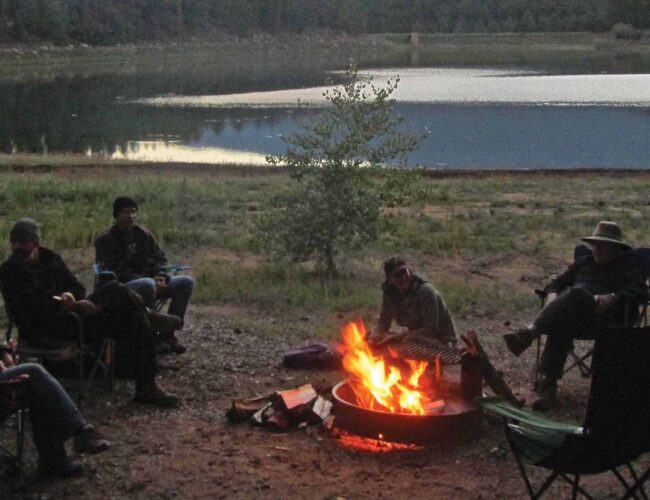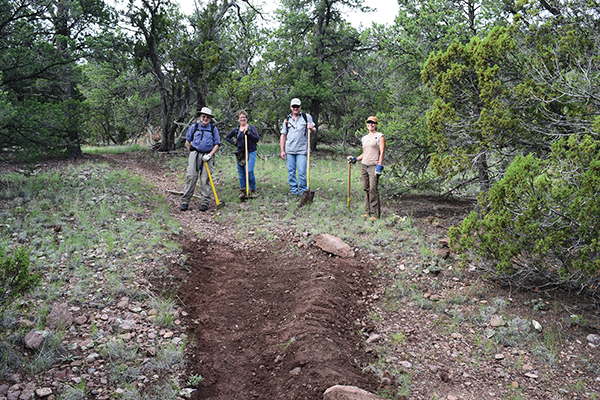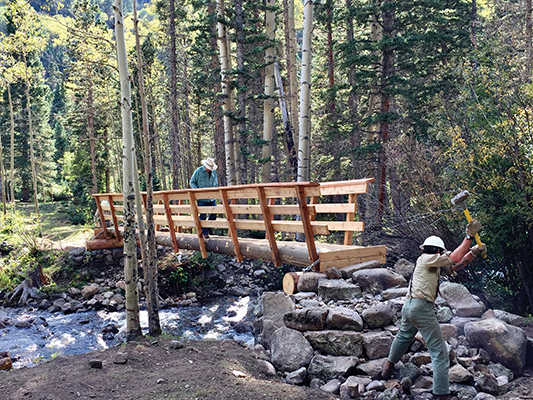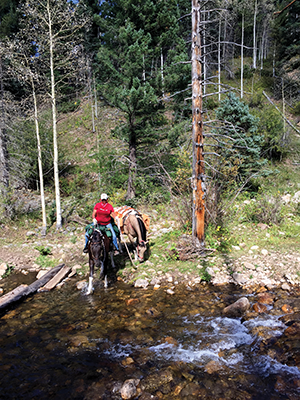Love is a Verb
Unsung heroes break, bushwhack, and preserve New Mexico’s trails. Their payment? Sore muscles, kinship, and satisfaction.
 Some well-deserved R&R at a Morphy Lake camp fire goes a long way for NMVFO folks after building as much as 3,000 feet of trail. Photograph by Larry Benson.
Some well-deserved R&R at a Morphy Lake camp fire goes a long way for NMVFO folks after building as much as 3,000 feet of trail. Photograph by Larry Benson.
BY LES DALY
In the year 1968, America was in turmoil. It was a time of war, assassinations, riots, and burnings.
It was also a year in which, miraculously perhaps, the nation managed in the midst of its turbulence to look to its future and the richness of its serenity. Spiritually led by the words of author and environmental trailblazer Rachel Carson, and driven by President Lyndon B. Johnson and Secretary of the Interior Stewart L. Udall, the Congress in that otherwise dark year raised its eyes to appreciate the scenic wonder of America, and created landmark legislation called the National Trails Systems Act. It was passed by voice vote in the Senate and overwhelmingly (378–18) in the House.
At that moment, the Congress memorably managed to think broadly about the “enjoyment and appreciation of the open air,” and called for the establishment and maintenance of trails “for people of all ages, interests, skills and physical abilities.” The legislation is about the trails, yes. But, above all, it’s about the inherent dignity of all Americans who deserve to experience their country’s trails, rivers, streams, mountains, deserts, and forests.
Knowing that government agencies at all levels are understaffed and underbudgeted and probably always will be, Congress sought in the Act to “encourage and assist volunteer citizen involvement” to take care of the national treasure that is our trail system.
Hundreds of volunteers partner regularly with the National Parks Service, the Forest Service, the Bureau of Land Management, and an array of state and local agencies to fulfill the meaning and intent of those legislated goals. It is those volunteers who often do much of the grunt work of building, repairing, maintaining, and sustaining the trails the half-century-old act protects.
Angélica Sánchez-Clark, a historian for the National Park Service in Albuquerque, sees many of the trails as “ancient footprints.” Sánchez-Clark says that before the arrival of any Europeans, Indigenous tribes and groups forged and used trails that supported “this incredible trade network around the region that was also a two-way network. Indigenous people were trading back and forth, even down into Mexico and Central America. These routes were well known to them, and later the Spanish and the French and the Americans learned the way.
“However, Indigenous footpaths were not always useful for people on horseback, and later horseback trails were not always adequate for people and horses and oxen pulling two-wheeled carretas and four-wheeled carts. So trails for different purposes grew up alongside each other, or simply changed in nature to accommodate the needs of the people.”
The many trails that vein New Mexico are still not static. They demand regular care and attention: building, rebuilding, reshaping, water management, and, unfortunately, cleaning up after people who leave campsites in shameful condition.
“Giving back” is something of a hymn among volunteers who come in all shapes and sizes, ages and experiences. Some sign up for one-day or weekend work projects perhaps a couple of miles from a trailhead. Others march deep into the forests, backpacking for days at a time to help a trail, especially in the wilderness areas. They hike, bike, four-wheel drive, or ride horseback across streams and into the forests to help keep New Mexico’s trails accessible and safe.
Late this past summer, a group of teenage girls gathered around a picnic table at the Big Tesuque campground in the Santa Fe National Forest. They were from the local chapter of Girls Inc., a national organization which works to inspire girls, especially those underprivileged or at risk, to be “strong, smart and bold.”
Jennifer Sublett, the Forest Service’s volunteer coordinator in the Santa Fe National Forest, briefed the girls on the right way, the wrong way, and the dangerous ways of handling the tools they would use to do the job.
“You’re going to be working outside and near each other,” Sublett began cheerfully but seriously, “and the things we don’t want to see are blood, brains, bruises, bones, blisters, bumps; keep all that inside.”
The Girls Inc. battalion didn’t flinch. Sublett showed them the heavy tools they would carry carefully at their sides, not on their shoulders where heads abound: a standard shovel that looked normal but was sharpened finely on the blade so it might cut through roots, or worse; the double-bladed Pulaski, an axe on one side, a hoe on the other; the McLeod, a twinned rake and hoe. These and other tools commemorate the former Forest Service specialists who conceived them more than a century ago. The volunteers were ready, it appeared from the fierce equipment, either to fix a trail or to attack a medieval fortress.
Sublett demonstrated how to massage the nicks and bumps and berms that shape or distort the trail, all to let water flow off the pathway and down the hill as it’s supposed to. They worked conscientiously for hours in twos and threes. And when the monsoon rains came later that afternoon, the water did as they had directed, rushing downhill, leaving Trail 152 solid, sustainable and enjoyable. Sublett gave the girls an A. The girls said they wanted to come back.
“They’ve gotten so much from the outdoors,” said Girls Inc. Director of Programs Madonna Hernandez. “They’ve hiked, camped, backpacked. It’s the being there, the atmosphere, the trees, the smell of the tall grasses, the sound of the birds. They want to give something back.”
New Mexico Volunteers for the Outdoors is an organization that has been working for thirty-six years to make the trails a better place, or to make trails where there are none. As many as sixty NMVFO folks may be out working on various projects on summer weekends, generally in groups of just a half dozen or so, says Project Coordinator Christopher Fritzsche. Echoing Sublett and her teenagers, he says, “We try to limit the size of the groups working on a single area….There are a lot of tools moving around in every direction. With a crowd, it can be dangerous.”
Apparently, it can also be a habit-forming vacation. “Most, though not all, are retirees or empty-nesters who come back season after season,” says Fritzsche.
The NMVFO repairs trails and drainage, and often cuts new trails through the forests in various parts of New Mexico, directed by federal and state agencies. A day and a half-long project this year involved cutting new trail in undeveloped parts of the Datil Well Recreation Area, about 60 miles west of Socorro near the Very Large Array. Another, in conjunction with state officials, was planned for Morphy Lake State Park in the Sangre de Cristo Mountains near the Pecos Wilderness.
On a weekend “vacation,” volunteers may work on needy trails or create as much as 3,000 feet of new trail, often through difficult terrain. While the volunteers get there on their own and come equipped with their own tents, camping gear and heavy work clothes, on many projects the NMVFO does provide a cook and some meals.
Sublett and her Forest Service colleagues oversee some 600 miles of trails in Northern New Mexico. They can call on about 100 volunteers to help. “I’d like perhaps twice as many,” she says, but the shortage of professional staff to manage such a force currently makes that impossible. Individual enthusiasts include Kevin Balciar, an architect originally from Wisconsin, who has been volunteering for trail care for about twenty-five years, often deep into the wilderness. He received his certification to wield a two-man cross-cut saw, necessary to clear sections of fallen trees, after a training program from Sublett.
“I dream up a project, and tell the Forest Service in order to get their OK. Then I round up some people, and we pack in,” he says. Sometimes, he does nine-day work outings with up to a dozen or more volunteers. “Volunteers are great to be around. Once they get started it’s like a chain reaction. I look forward to it every year. After it’s over, I’m glad it’s over, and then after three or four days I’m looking forward to the next one.”
Because he generally works on trails in the protected wilderness where vehicles are prohibited, Balciar has great admiration for the Back Country Horsemen of America (BCHA). Their members plunge into the forests on horseback, pack horses in tow, carrying in loads of equipment and supplies and carrying out the trash bags of debris Balciar and his team find. “Some of those campsites are pretty raunchy,” Balciar says.
Last year, the Santa Fe chapter of BCH collaborated with a half dozen or so former smokejumpers, those hardy souls who in their younger days were trained to parachute in to fight forest fires. Nine men and women on horseback hauled every piece of material—timbers, wire, tools and provisions—3 miles and thirteen pack trips into the forest. In a week, the smokejumpers, who trekked in, had built a long-needed heavy wooden bridge over the Rio Santa Barbara in the Carson National Forest. Then BCHA rode out the excess materials for the next project.
Not all volunteers are people with time on their hands. Consider Debbie Spickerman of the BCHA. Out of her home north of Hernandez, she cares for a string of horses, operates a full-time dog-grooming business, and designed and built an elevator-equipped ADA-certified vacation rental apartment above her garage. On top of that, she pitches in regularly with her BCHA mates on the trail maintenance work. She helped organize the bridge-building project with the smokejumpers and seems continually on the lookout for trails that need help. With the Forest Service, she and the smokejumpers identified some in the San Pedro Parks Wilderness area and the BCHA rode in equipment for a team of the smokejumpers to do a week of trail-clearing work.
Last year, she says with deserved satisfaction, the Santa Fe BCHA women and men logged nearly 650 hours and 150 miles in the saddle working on the trails.
More recently, Spickerman launched a project with her BCHA friends and some four-wheel clubs to ford the Rio del Oso, and then to clean up what was, a long time ago, a Native American trading trail—one of Sánchez-Clark’s “ancient footprints.”
“It is reasonably accessible and it gets incredibly trashed,” says Spickerman, with irritated amazement. “Sofas, recliners, cell phones, shotgun shells, cans and bottles, car parts, syringes, and even prescription bottles.” Spickerman donated the rental of a dumpster ($700 for the weekend) to haul away the leavings on the Rio del Oso trail. “The Forest Service doesn’t have the budget or the dumpster,” she explained.
The Forest Service tries to protect trail sites with archaeological value. As Anne Baldwin (Heritage staff, Forest Service, Española Ranger District) explained, efforts are made to recognize grid gardens, where previous generations grew corn, beans, and squash, and to avoid mounds and terraces or arrangements of rocks, suggesting ancestral sites that are to be left undisturbed.
Henry Lanman is a native-born New Mexican who finally returned after retiring from a lengthy career as a fire captain in Contra Costa County, California. If Debbie Spickerman gets to her trails on horseback, Lanman gets there on his mountain bike as a busy member of the Santa Fe Fat Tire Society.
Lanman and his bike groups (sometimes as many as twenty volunteers) have done considerable work over the years on the popular Windsor Trail near the Santa Fe ski area, all under the direction of the Forest Service. He takes pride in having repaired and stabilized a shepherd’s trail that dated from the 1800s. And the Fat Tire Society claims the creation of more than 10 miles of new trails in the Galisteo Basin Preserve.
And then in the Albuquerque community of Martineztown there is the kind of “volunteer citizen involvement” that Congress might have been envisioning—in this case, not to build or maintain a trail, but to memorialize creatively for recreation a great trail that used to be.
Though it is not very large, Martineztown might be thought of as a historic trifecta. It sits astride the crossroads of “ancient footprints” left by a number Indian tribes over centuries. It is also over a great acequia that was a watering and resting place for shepherds in the 1800s. Most markedly, it is directly on El Camino Real de Tierra Adentro, the Spanish Royal Road of the Interior, a route linking provincial capitals that spanned 1,600 miles from Mexico City to Ohkay Owingeh, for a short time the Spanish capital of New Mexico. Evolving as historian Sánchez-Clark related, El Camino Real de Tierra Adentro eventually became the general path of Interstate 25. In Albuquerque’s Martineztown, the original Camino Real is today known as Edith Boulevard.
Enter Frank H. Martinez. His name and that of the community is a coincidence. He lives today in the Edith Boulevard home where he was born and where, he declares, twelve of his sixteen siblings were born, too. In another era Frank Martinez might have been called a populist revolutionary and, at seventy-one, he still looks the part. Since he was a student at the University of New Mexico nearly fifty years ago, he has led an ongoing campaign to preserve the community of Martineztown from civic demolition and to create there an emerald of a park to mark the Camino Real on which it stands.
With the eventual financial support of the city and the state and creative help from the National Park Service, the neighborhood produced an innovatively designed little space—barely two acres—that brilliantly presents history described often as it was experienced four centuries ago. Here, the long, arduous Camino Real de Tierra Adentro is in miniature, a paved path 1,940 feet long. Marked along the pavement is the distance from Mexico City to every later American county it touched: El Paso, 1256 miles; Bernalillo 1,509; Santa Fe 1,580; all the way to Rio Arriba County, 1,628 miles from Mexico City.
A large wheel of history is inlaid in the ground, presenting many of the important events in the overlapping Indian and Spanish and later American life of New Mexico. Recorded there is the coming of explorer Juan de Oñate and his founding of a capital at Ohkay Owingeh in 1598, the Pueblo Revolt in 1680, the Treaty of Guadalupe-Hidalgo in 1848 that ended the Mexican-American war, the granting of statehood in 1912, and much in between.
The park trail is landscaped with indigenous plants, vivid tile portraits of local wildlife, and decorative interpretive signage. Martinez, Sánchez-Clark, and Aaron Zahm, of MRWM Landcape Architects in Albuquerque, thoughtfully turned to period writings such as those of Fray Alonso de Benavides to describe details of the life, vegetation and wildlife he saw along the Camino Real when he made the journey in the year 1630.
Of the role of mule deer in 1630, for example, the trail markers depict the animal and share his observations: “There are quite a few … deer, and these sustain the Indians and provide clothing for them. They prepare and cure the deerskins into excellent chamois leather, which they sell in Mexico City for five or six pesos each.”
Martineztown Park is maintained and sustained today by Albuquerque’s Parks and Recreation Department. Unfenced and ungated, it seems protected by the respect of the community. Statistics from the Albuquerque Police Department suggest it has been one the least-troubled parks in the area.
“We reclaimed our history and sense of place,” Frank Martinez says. It’s also simply a pleasant neighborhood spot for a picnic gathering with family, friends and New Mexico’s ancestors.
If the marching hymn for many of the volunteers along the trails of New Mexico is “giving back,” an additional stanza for Frank Martinez and his community neighbors on the Camino Real might just be “bringing back.”
Les Daly has reported for such publications as Smithsonian and the Atlantic, and frequently on a variety of interesting people and subjects for El Palacio.








